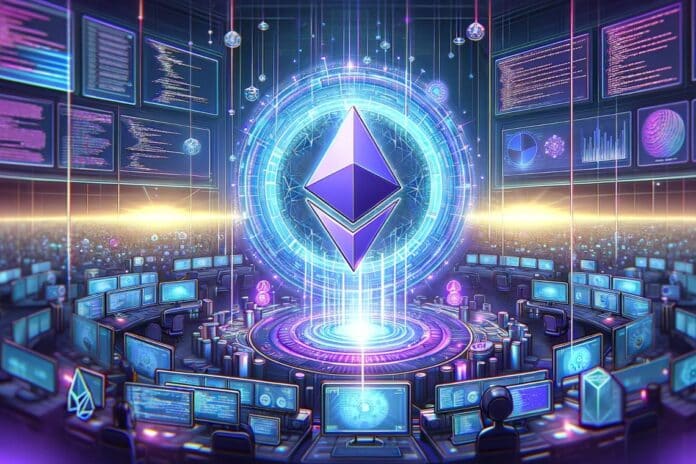Yesterday, the long-awaited “Dencun” update of the Ethereum blockchain was fully activated on the Sepolia testnet, taking an important step forward for scalability and reducing transaction costs on the infrastructure’s rollups.
With Dencun, the concept of “proto-danksharding” is introduced, an essential element for the world of second-level chains.
Now all eyes are on Holesky, the third testnet of Ethereum, where the last implementation of the update will take place next week.
Afterwards, the developers will also launch Dencun on the mainnet.
Let’s see all the details below.
Summary
Update “Dencun” launched on the second Ethereum Testnet: Holesky will be next on February 7th
Yesterday, at 22:51 UTC (23:51 Italian time), the “Dencun” update was successfully launched on the Sepolia testnet of the Ethereum blockchain, concluding in just 19 minutes.
This step of the Ethereum roadmap involves testing the Dencun functionalities in the second of the 3 test networks of the famous decentralized infrastructure.
At the beginning of this month, in fact, the same update was carried out on the Goerli testnet with some difficulties, while on February 7th it will be Holesky’s turn.
Below is the official program presented in the latest post of the Ethereum Foundation Blog.
Before Dencun, the last update of the Ethereum blockchain was Shapella, which opened the doors to unstaking previously locked ether in the ETH 2.0 contract.
This latest revision by the developers of the cryptographic network represents a milestone for the entire decentralized sector, as it lays the foundation for the introduction of the concept of “proto-danksharding”.
Introduced with the EIP-4844 proposal, proto-danksharding improves the efficiency of second-layer rollups on Ethereum making transactions cheaper and scalable, with a focus also on data availability.
With this innovation, a new type of transaction known as “blob” is introduced, which allows the addition of pieces of information known as large binary objects or “blob”, in order to increase the amount of data carried by the blocks.
In essence, it is a solution to partition databases into smaller ones that manage specific data segments, thus improving the efficiency and performance of these databases.
It is estimated that Dencun, after complete implementation, will allow the Ethereum network to handle more than 100,000 transactions per second in a more cost-effective manner.
The co-founder of Ethereum, Vitalik Buterin, recently expressed his positive opinion about this new feature, explicitly stating his support in an explanation to the community:
“A transaction that carries a blob is like a normal transaction, except that it also carries an extra piece of data called a blob. These are extremely large (~125 kB) and can be much more cost-effective compared to similar amounts of call data.”
Now that Dencun has been successfully launched in Sepolia, the industry experts’ attention is focused on Holesky with the implementation update scheduled for February 7th.
Then if everything goes as planned, the blockchain developers will launch the update on the mainnet in the coming weeks, finally introducing proto-danksharding on rollup L2.
The success in yesterday’s stage was enthusiastically shared by the entire Ethereum community, including the research company Nethermind.
Will the update have a positive impact on the long-term price of ETH?
Considering the strong expansion of layer 2 chains on Ethereum, developers believe that Dencun will be an essential upgrade to support the growth of the entire cryptographic ecosystem.
The completion in the Sepolia testnet lays the foundation for the implementation of the proto-danksharding function that will make the rollup space extremely more efficient, with many advantages for the end user in terms of scalability and cost-effectiveness of transactions.
All of this, although not directly related to the price movement of the ETH cryptocurrency, can only strengthen an infrastructure that is already essential in the web3 world, leading to an increase in the intrinsic value of the underlying technology.
The expansion of Ethereum’s layer-2 with Dencun can continue at a much faster pace, making networks like Abitrum, Optimism, ZkSync, Starknet, and Manta Pacific competitive with the transaction costs offered by alternative EVM networks.
According to L2fees data, currently the most “cost-effective” L2 network to use is ZkSync Era with 6 cents for a token transfer.
Solana far surpasses this record with a cost of 0.0002 dollars for the same operation.
As written by an Ethereum developer on the official website of the cryptographic network:
“Danksharding is the way Ethereum becomes a truly scalable blockchain, but several protocol updates are needed to get there. Proto-Danksharding is an intermediate step along the way.”
The road to maximum scalability (technically a utopia), is still long and Ethereum for many months will continue to be the safest environment in terms of smart contracts but not the most cost-effective.
Over time, the progress we are witnessing today with Dencun landing on Ethereum’s testnets will make the entire ecosystem ready to face bigger challenges, competing with the needs that the mainstream audience will advance in the coming years.
All of this, although the effects may not be blatantly visible today, greatly increases the value of the blockchain in question, and therefore also of the ETH resource.
Therefore, in conclusion: the completion of Dencun on Sepolia is super bullish and could create the conditions for a truly significant improvement of the chain.
If Ethereum becomes more performant than other competitors, there will be no one left behind and the value of ETH will become invaluable as the only means to power a virtual machine that seamlessly, decentralized, and irreversibly connects the requests of all major on-chain participants.
We expect a super bright future for ETH after this update.




